Alzheimer Patients and Traditional Cognitive Stimulation or with Specific Software: the Gradior Software
Evaristo Barrera Algarín* and María Isabel Barrientos García
University of Pablo de Olavide, Spain
Submission: February 25, 2020; Published: March 13, 2020
*Corresponding author: Evaristo Barrera-Algarín, Universidad Pablo de Olavide, Facultad de Ciencias Sociales, Carretera de Utrera, 41013-Sevilla, Spain
How to cite this article: Evaristo Barrera Algarín, María Isabel Barrientos García. Alzheimer Patients and Traditional Cognitive Stimulation or with Specific Software: the Gradior Software. OAJ Gerontol & Geriatric Med. 2020; 5(4): 555666. DOI: 10.19080/OAJGGM.2020.05.555666
Abstract
Study to check if cognitive stimulation through the Gradior software offers better results than cognitive stimulation without software support, in Alzheimer’s disease people. Quasi-experimental methodology with an experimental group (8 subjects) that use the Gradior program as cognitive stimulation therapy, and a control group (8 subjects) that does not use Gradior software. The sample comes from a Nursing Home and a Diurnal Stay Unit, with subjects that are between the different phases of the disease, excluding those subjects with severe impairment that impedes communication and execute scales. Using a brief questionnaire and the Minimental State Examination (MMSE) scale, in a correlational and comparative analysis, and the nonparametric test Mann-Whitney U. It has been verified the hypothesis that the people who carry out therapy with the Gradior program present improvements or maintain their cognitive levels. To conclude, it can be stated that there is a relationship between the improvement in the level of cognitive impairment and the Gradior program. These data are of interest to the different professionals who require cognitive stimulation work with Alzheimer patients or residents, increasing the efficacy and incidence of cognitive therapy.
Keywords: Alzheimer; Therapy; Cognitive stimulation; Gradior software
Introduction
According to the WHO (2020) dementia is not a normal consequence of ageing, although it mostly affects older people. Approximately 50 million people worldwide suffer from dementia, with 10 million new cases recorded each year. Among the different dementias, Alzheimer’s disease (AD) is the most common form, accounting for between 60% and 70% of the total. According to Gamito, et al. [1], Western society is ageing and, as has been pointed out, the number of dementias is increasing every year, including Alzheimer’s disease. This is why new solutions are needed to tackle this problem, such as the use of Information and Communication Technologies (ICT) as cognitive stimulation therapy, which has grown considerably in recent years.
The main objective of cognitive stimulation is to strengthen the intellectual capacities of the affected person and slow down the progression of cognitive impairment, in order to maintain their layers as long as possible. Cognitive rehabilitation can be carried out in different environments (home, old people’s homes...) and can change in the way it is carried out (analogue or digital support). The development of information and communication technologies (ICTs) has long allowed the generation of software for the rehabilitation of cognitive functions, making it possible to respond to the care needs of older people, so that interventions can reach a greater number of people Toribio-Guzmán et al. [2]
Combination therapy is also effective in improving cognitive functions, with orientation, attention, concentration and executive functions being the areas most benefited. It is also capable of preventing the progression of apathy, the loss of disease consciousness and the worsening of participants’ moods. It also improves functioning in the basic activities of daily living [3]. An example of this is the Smart brain System that has scientifically proven the therapeutic efficacy of the system to treat and care for any case of cognitive impairment, in addition not only Alzheimer’s disease, but others such as brain damage or mild cognitive impairment, among others [4]. According to Guerrero’s research, preliminary results suggest that computer cognitive stimulation may be more effective than traditional cognitive stimulation, especially while it is maintained [5]. At the international scale we find a wide range of possibilities to work cognitive stimulation through computer software. Some of these studies are shown in (Table 1).
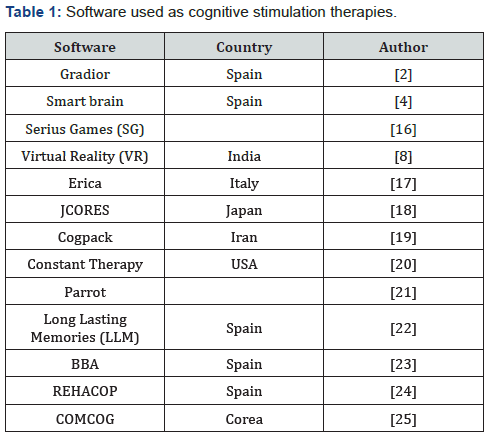
In the same way, other recent studies have demonstrated the efficacy of video games in improving cognitive processes affected by the physiological effect of aging, neurodegenerative diseases or others, with potentially beneficial effects. The Pervasive game for personalized treatment of cognitive and functional deficits associated with chronic and Neurodegenerative diseases (PERSON project) proposed new tools for cognitive rehabilitation, with the aim of improving the quality of life of patients with cognitive deficits, especially in the early stages, through the use of sophisticated and non-invasive technology [6]. Similarly, Fasilis et al. [7] also obtained results that showed a relative improvement in the total cognitive variables considered after completion of the neurorehabilitation program, with this stimulation software model [7]. Others, such as Deep and Jaswal, have gone a little further in their studies, observing how Virtual Reality RV therapy has many advantages over conventional therapies, becoming today a very appropriate option for the treatment of cognitive stimulation [8].
Therefore, we have to understand that technology-based cognitive training and rehabilitation interventions are very promising. However, Ge and others believe that future studies should consider the use of more consistent methodologies. Appropriate control groups should be designed to understand the additional benefits of cognitive training and rehabilitation using technology [9].
In this study, one of the cognitive stimulation therapies is addressed, using neuropsychological training and rehabilitation software, the Gradior software, used in centers all over the world, from the social and health areas [10]. It is assumed that cognitive rehabilitation, through a specialized computer program, means an improvement in the level of cognitive deterioration in people with Alzheimer’s disease. This is confirmed by studies such as Fumero [11], carried out in Spain, Italy, Greece, the United States, Japan and Korea. The intervention with the Gradior program, in addition to being a very useful resource [12] because it is presented as a tool used by professionals offering an efficient way of working [2], can facilitate the practice of cognitive rehabilitation (see Figure 1) as it can be used in the domestic environment [13]. (Figure 1)
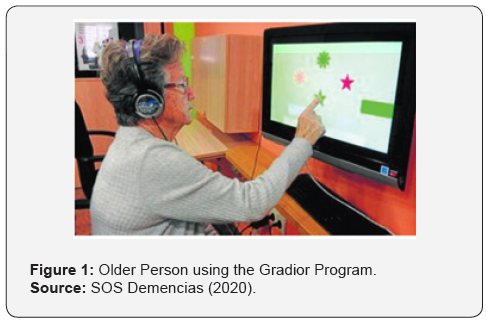
Our study is based on the idea that the use of specialized software is beneficial for the maintenance or even improvement in cognitive impairment levels on Alzheimer’s disease people. Currently, the use of new technologies is becoming more widespread, reaching the use of cognitive rehabilitation, making the computer as a tool accessible to clinical professionals and therapists. This technological growth makes it possible to work more efficiently. The Gradior computer program, compared to other therapies with the same purpose, adapts to the needs of the individual, graduating accurately several parameters, performing attractive and fun activities, keeping the person motivated.
On the other hand, this software produces a feedback on the performance and development of the person, not being necessary the individualized attention. This therapy is carried out by means of touch screens, so it is not difficult to use.In addition, Gradior allows to make statistical graphs about the evolution of the patient. This is very useful for professionals, since they can continue to advance in the study of Alzheimer’s disease, as well as design a rehabilitation itinerary according to the deterioration that the person presents [2].
Methodology
The research’s goal was to check if cognitive stimulation through the Gradior software offers better results than cognitive stimulation without software support, in Alzheimer’s disease people. The hypothesis: People with Alzheimer’s disease who carry out therapy with the Gradior program present improvements or maintain their cognitive levels. Bearing in mind our objective and hypothesis, a quasi-experiment with pre-test and post-test, between 2018-1019 (duration of 7 months), has been carried out in elderly people suffering from Alzheimer’s disease. The subjects (universe) were selected from the Seneca elderly care home and the San Rafael Day Care Unit in Córdoba. From the universe, 16 subjects were selected, who meet the following criteria: elderly people with Alzheimer’s disease, of Spanish nationality, use of the Gradior program as cognitive stimulation therapy (experimental group), use of other non-GRADIOR cognitive stimulation therapies (control group). The people used as samples, reside or attend the workshop, the centres where the research has been carried out, which have been the following: Seneca Córdoba Retirement Home and San Rafael Alzheimer’s Association, located in the city of Córdoba. In the Seneca residence (experimental group), people who suffer from Alzheimer’s disease and do not carry out cognitive therapy through the Gradior program, carry out other cognitive workshops: group cognitive stimulation workshops, Montessori method, memory arrangement workshop, reading and writing workshop. The professionals in charge of carrying out the cognitive therapy through the Gradior computer program are psychologists. These professionals are previously trained in all the particularities of the program, to know in detail how it works and how to apply it. After this training, which is done in person, a degree is obtained to be able to work with cognitively impaired people, in order to maintain or delay this deterioration. On the other hand, at the San Rafael residence, people who suffer from cognitive impairment, and who do not use the Gradior program as cognitive therapy, attend occupational therapy and memory workshops (control group).The following table describes the sample data (Table 2).
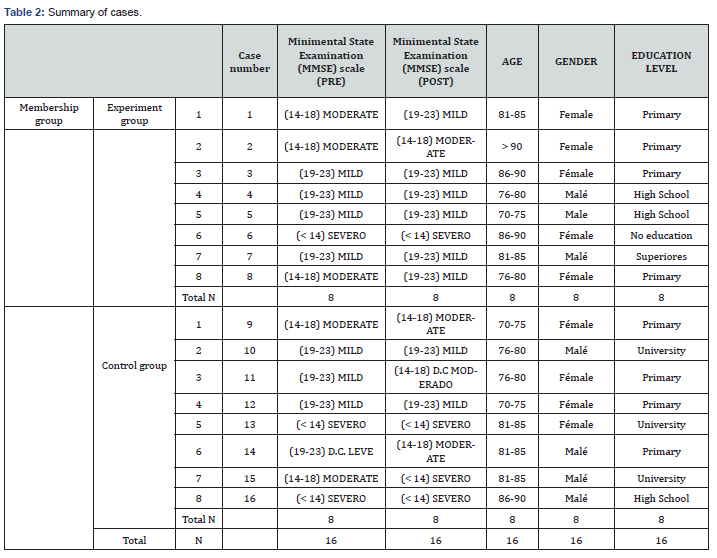
As can be seen in (Table 2), the average age of the participants is 81.56 years, although the age range varies from 74 to 92 years. The average age of the experimental group is 80 years, and the control group is 80.62. With regard to sex, there are a total of 9 women and 7 men. In the experimental group there are more women (5 participants) than men. As for the control group, it presents 50% women and the same percentage for men.
Finally, according to the level of studies, there is one person without studies, a total of 8 participants who have primary studies, 3 subjects have secondary studies, and within the group of higher studies there are 4 participants. It is observed that both the experimental group and the control group each have a total of 4 participants with primary studies. In the experimental group, there are 2 people with secondary studies, as opposed to 1 subject with the same level of studies in the control group. On the other hand, in the control group it presents a greater number of participants with higher studies, with a total of 3 subjects. However, it can be observed that of all the sample present in the quasi-experiment, there is only one person without studies located in the experimental group.
Those subjects with severe impairment that prevents communication and execution of scales have been excluded from the sample. The study was carried out in accordance with the Code of Ethics for Social Work and the International Federation of Social Workers, and Organic Law 3/2018 of 5 December on the Protection of Personal Data and Guarantee of Digital Rights (Spain). After the signatures of the consents on the part of both those responsible and those involved, a brief questionnaire and scale were administered.
The variables on which the research focuses are the following:
I. Sociodemographic variables: Firstly, an instrument has been used to collect the sociodemographic variables of interest for the research, this is a brief initial questionnaire. The aspects collected in this instrument are age, sex and level of studies.II. Cognitive Impairment: Subsequently, the Mini Cognitive Examination Questionnaire (MEC) was used [14]. It is based on an assessment scale, the objective of which is to detect the existence of cognitive impairment and to measure its degree, as well as to reveal possible functional disorders in a quick and practical way [15]. This is a Spanish translation of Folstein’s Minimental State Examination (MMSE), and others, by Lobo, and others [14]. Their psychometric properties are good: Sensitivity (87%) and specificity (92%) for scores below 24. It has a positive predictive value of 69% in people over 74 years of age. It measures the subject in 5 evaluable cognitive areas. In first place are the questions related to the orientation, adding a total of 10 points of the valuation. In second place is the fixation memory, with a total of 3 points on the final valuation. Subsequently there are the operations of concentration and calculation, presenting a total of 8 points. The deferred memory is then presented, with a total of 3 points. Finally, there is the area referred to language and construction, adding a total of 11 points on the total valuation of the scale. The interpretation of this scale is the sum of the scores obtained for each of the items, the maximum score being 35 points. The cut-off point for diagnosing a person with cognitive impairment is 23 points. The score of 24 or more shows no cognitive impairment. A score between 19 and 23 points indicates mild cognitive impairment, between 14 and 18 points is moderate cognitive impairment, and finally, a score of less than 14 points is severe cognitive impairment. It is a scale used as a screening test of the cognitive impairment of people used as a sample in the research.
Stimulation with GRADIOR Program: It is the variable dependent on the research, determining the belonging to control group and experimental group, and base for the effective determination of hypothesis and research objective, in which the 16 analyzed subjects were included. Gradior is a software used for rehabilitation and cognitive stimulation, this is aimed exclusively at professionals working with patients with cognitive impairment for different causes (dementia, mental illness, brain damage, aging ...). This program is based on a series of cognitive activities to improve memory, as well as intellectual capacity, through visual and auditory instructions and interacting with a touch screen, although it can also be used with a mouse. With these 16 subjects, a quasi-experimental research (because randomness cannot be applied) of the type ‘nonequivalent comparison group design’, with an experimental group (linked to the stimulation variable with Gradior Program), and a control group, is started. In both groups, pre-test and post-test observation measures are administered. The methodological process is exemplified in the following (Table 3).
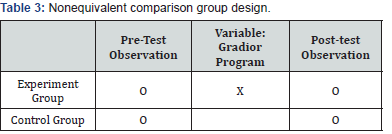
The data obtained were worked with Excel and analysed with the IBM SPSS Statistics 22 software. Our instruments obtained high reliability (‘863). In the case of groups of less than 30 subjects, for the acceptance or rejection of the null hypothesis (H0), the non-parametric Mann-Whitney U test will be used.
Results
In order to demonstrate the positive relationship between the Gradior program and the cognitive improvement of people suffering from Alzheimer’s disease, an analysis of the data from the experimental group and the control group was carried out, linking them to each of the cognitive deterioration phases, in the pre-test and in the post-test (Figure 2).
The Figure 2 shows how the experimental group has improved in both mild and moderate cognitive impairment: from 4 participants with mild cognitive impairment in the pre-test, to 6 in the post-test. In moderate cognitive impairment, in the pre-test there was a result of 3 subjects, and in the post-test of 1. Finally, in severe cognitive impairment the number was maintained at 1. It can be seen in the control group that has worsened in each of them. In the mild cognitive impairment, from a result of 4 in the pre-test, it passes to 2 in the post-test. In moderate cognitive impairment, it increases in 1 more in the post-test, as well as in the level relative to severe cognitive impairment. (Figure2) shows visually how the experimental group shows improvements in cognitive impairment, as opposed to the control group that worsens in terms of cognitive level. Subsequently, a comparative study of means was carried out. The following table shows the results obtained from the variables of the experimental and control groups, and from the results derived from the MMSE scale, in the pre-test and post-test (Table 4).
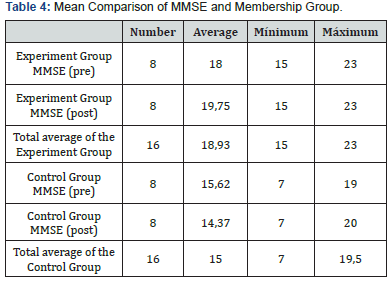
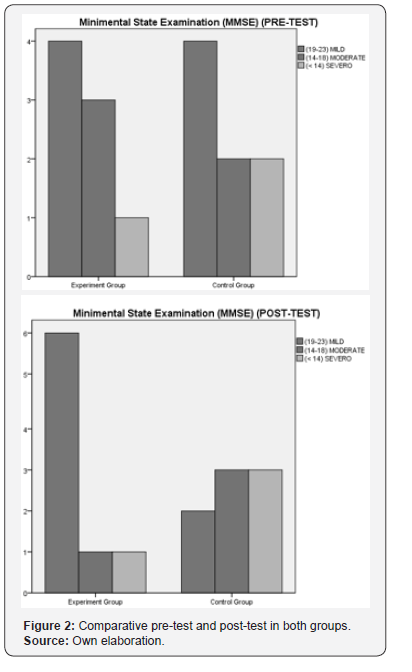
As can be seen in Table 4, according to the result of averages obtained in the pre-test, the experimental group has a score of 18, as opposed to 15.62 points in the control group. Analyzing the post-test, it is deduced that the experimental group presents an average of 19.75 points, while the control group shows an average of 14.37 points. In addition, considering the experimental group, it can be observed how it has presented improvements, going from a moderate cognitive deterioration with an average of 18 points, to a slight one with an average score of 19.75. However, the control group remained in the phase of moderate cognitive impairment, worsening the score, going from an average of 15.62 points at the beginning, to 14.37 in the post-test examination of the MMSE. With regard to the cognitive impairment variable, analysing the results of the previous examination, it is assumed that the experimental group (mean=18) presents less cognitive impairment than the control group (mean=15.62), although both groups are at the threshold of moderate cognitive impairment (14 to 18 points). Taking into account the examination carried out a posteriori, the experimental group improved (mean=19.75), moving to the phase of mild cognitive impairment (from 19 to 23 points), as opposed to the control group (mean=14.37), remaining at the same level of cognitive impairment, although the mean score decreased. The comparison of averages informs us of a cognitive improvement in the experimental group. At the end of our study, we performed a PEARSON-type correlation analysis of the pre-test and post-test tests in the experimental and control groups. On this we generate (Table 5).
This analysis confirms our hypothesis. That is, there is a significant correlation ,761 (significance ,001; N=16) between the pre-test of the experimental group and the control group. After the work with the Gradior Cognitive Stimulation Software, we see that the stimulated group, experimental group, sees the correlation between its pre-test and post-test measurement rotated, while in the control group, the correlation ,806 (significance 0.016; N=8) has been maintained between its pre-test and post-test tests. In order to consolidate the analysis results, we decided to apply nonparametric Mann-Whitney U test (Table 6).
As we can see in (Table 5), Mann-Whitney’s U gives us a value of 30,000 in the Pretest tests, with a p value (bilateral asymptotic significance) of 0.819. This means that the null hypothesis (H0) is accepted as the value is above 0.05 (error level at 5%, α=.05). In other words, in the EQF pre-test, there are no differences based on the experimental or control group. But, in the same Table 5, the Mann-Whitney U gives us a value of 1.500 in the Post-test tests, with the p value (bilateral asymptomatic significance) being 0.001. This means that the null hypothesis (H0) is rejected as the value is below 0.05 (5% error level, α=.05). In other words, the alternative hypothesis (H1) is confirmed in the post-test tests of the EQF: people with Alzheimer’s disease in the experimental group show improvements in their level of cognitive impairment compared to the control group.
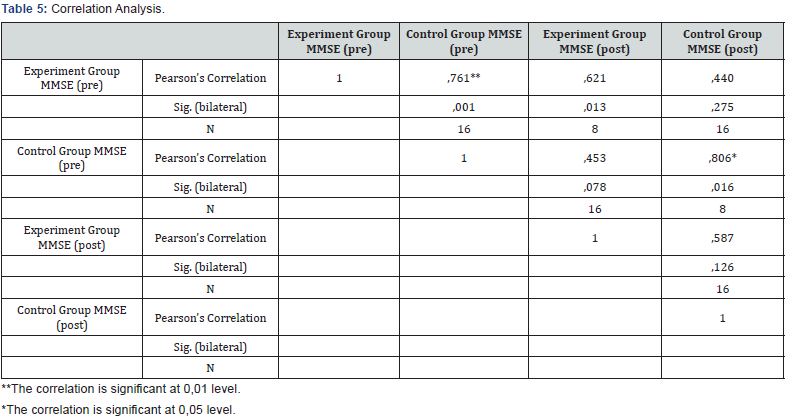
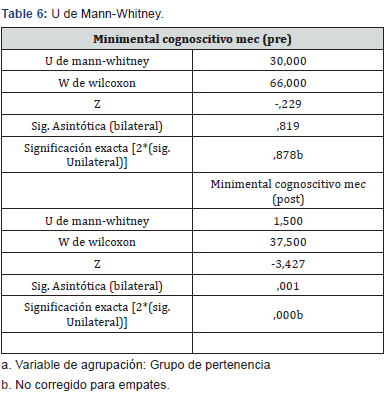
Discussion and Conclusions
On the basis of the results obtained, we considered the general objective achieved: cognitive stimulation through the Gradior software offers better results than cognitive stimulation without software support, in Alzheimer’s disease people.
In this way we can establish the following conclusions:
First, that the use of the Gradior program as cognitive stimulation therapy in people with Alzheimer’s disease generates an improvement in cognitive functions, as opposed to those people who do not carry out this therapy. These data are corroborated in the descriptive frequencies of the experimental group and the control group; in the comparative analysis of means; and in the analysis of correlations described. In this sense, it coincides with the works of, or those worked by Pérez [4] on Alzheimer’s Disease. They also coincide with the contributions of PERSON already foreseen by Monaco [6], or with the improvements demonstrated by Fasilis [7] on cognitive stimulation.
Second, the importance of cognitive stimulation using computer software is demonstrated. This coincides with the reflections presented by Gamito [1]. In fact, these elements were also defended and described by the contributions of Toribio-Guzmán [2]. In the same sense we see connections with other similar works carried out in different countries [4,8,16- 25]. Specifically, we understand that cognitive stimulation using software can be more effective than traditional cognitive stimulation, especially while it is maintained [5].
Third, the Gradior Program is excellent software for cognitive stimulation in Alzheimer’s patients. These elements are in tune with the studies by Pérez-Turiel [10], or those contributed by Fumero [11], carried out in Spain, Italy, Greece, the United States, Japan or Korea, and which were also demonstrated by Harvey [12], Toribio-Guzmán [2] and Caroppo [13]. Fourth, we can find an important limitation at the sample level. A comparison with a greater number of control groups would be necessary in order to be able to discriminate well the additional benefits beyond what is carried out in this study. This also establishes a relationship with the considerations described by Ge, et al. [9] in the same sense (2018).
In any case, on the basis of the data obtained, we can state that we have confirmed our initial hypothesis, i.e. that people with Alzheimer’s disease who use the Gradior programme as cognitive stimulation therapy show improvements in their level of cognitive impairment, as opposed to those who do not use this therapy or use some other of the existing cognitive stimulation therapies. In future studies it would be interesting to look at the contributions of Deep and Jaswal [8] and see if, in addition, with the help of Virtual Reality (VR) there are greater advantages over conventional therapies.
References
- Gamito P, Oliveira J, Morais D, Coelho C, Santos N, et al. (2019) Cognitive Stimulation of Elderly Individuals with Instrumental Virtual Reality-Based Activities of Daily Life: Pre-Post Treatment Study. Cyberpsychol Behav Soc Netw 22(1): 69-75.
- Toribio-Guzmán JM, Parra Vidales E, Viñas Rodríguez MJ, Bueno Aguado Y, Cid Bartolomé MT, et al. (2018) Rehabilitación cognitiva por ordenador en personas mayores: programa Gradior. Universidad de Salamanca, Spain.
- García JA (2017) Eficacia de la rehabilitación del reconocimiento de emociones combinada con estimulación cognitiva en personas con enfermedad de Alzheimer. Doctoral Thesis, Universidad de Salamanca, Salamanca.
- Pérez B (2014) El Futuro de los Recuerdos? Estimulación cognitiva No Farmacológica con el apoyo de las TIC para enfermos de Alzheimer y otras demencias. In J. L. Hernández Huerta, En torno a la Educación Social. Estudios, reflexiones y experiencias pp. 93-104.
- Guerrero G (2017) Validación de una plataforma de rehabilitación cognitiva en pacientes con demencia. Doctoral Thesis, Universidad de Málaga, Má
- Monaco A, Sforza G, Amoroso N, Antonacci M, Bellotti R, et al. (2019) The person project: a serious brain-computer interface game for treatment in cognitive impairment. Health and Technology 9(2): 123-133.
- Fasilis TPS (2018) A pilot study and brief overview of rehabilitation via virtual environment in patients suffering from dementia. Psychiatriki 29(1): 42-51.
- Deep A, Jaswal R (2017) Role of management & virtual space for the rehabilitation of children affected with cerebral palsy: A review. 4th IEEE International Conference on Signal Processing, Computing and Control, pp. 293-299.
- Ge S, Zhu Z, Wu B, McConnell ES (2018) Technology-based cognitive training and rehabilitation interventions for individuals with mild cognitive impairment: A systematic review. BCM Geriatrics, 18(1): 213.
- Pérez-Turiel J, Franco-Martín M, Fraile JC, Parra E, Viñas P (2017) First results on the joint of e2rebot and gradior to improve cognitive abilities. Converging Clinical and Engineering Research on Neurorehabilitation II pp. 1293-1298.
- Fumero Vargas G (2015) Usabilidad de un programa de Rehabilitación Neuropsicológica por ordenador "Gradior" en personas con enfermedad grave y prolongada. Doctoral Thesis, Salamanca.
- Harvey P (2014) What is the evidence for changes in cognition and functioning over the lifespan in patients with schizophrenia? J Clinic Psychiatry 2:34-38.
- Caroppo A, Leone A, Siciliano P, Sancarlo D, D’Onofrio G, et al. (2016) Design and evaluation of an ICT platform for cognitive stimulation of Alzheimer’s disease patients. En S. Verlag (Ed.), 2nd EAI International Conference on Smart Objects and Technologies for Social Good, GOODTECHS pp. 106-115.
- Lobo A, Saz P, Marcos G, Dia J, de la Camara C, et al. (1999) Revalidation and standardization of the cognition mini-exam (first Spanish version of the Mini-Mental Status Examination) in the general geriatric population. Med Clin (Barc) 112(20): 767-774.
- González Palau F (2012) Eficacia de un programa de entrenamiento físico y cognitivo basado en nuevas tecnologías en población mayor saludable y con signos de Deterioro Cognitivo Leve: Long Lasting Memories. Salamanca.
- Robert P, König A, Amieva H, Andrieu S, Bremond F, et al. (2014) Recommendations for the use of serious games in people with Alzheimer's disease, related disorders and frailty. Front Aging Neurosci 6: (54).
- De Luca R, Leonardi S, Russo M, Aragona B, Torrissi M, et al. (2018) Improving Cognitive Function in Patients with Stroke: Can Computerized Training Be the Future? J Stroke Cerebrovasc Dis 27(4): 1055-1060.
- Matsuda Y, Marimoto T, Furukawa S, Sato S, Hatsuse N, et al. (2018) Feasibility and effectiveness of a cognitive remediation programme with original computerised cognitive training and group intervention for schizophrenia: a multicentre randomised trial. Neuropsychol Rehabil 28(3): 387-397.
- Sharifi V, Sedighnia A, Ataie S, Tabatabaee M, Tehranidoost M (2016) The effect of a computer-assisted cognitive remediation on improving cognitive functions in patients with schizophrenia: A before-after study. (M. U. Sciences, Ed.) Iranian Journal of Psychiatry and Behavioral Sciences 10 (4): e5132.
- Des Roches CA, Balachandran I, Ascenso EM, Tripodis Y, Kiran S (2015) Effectiveness of an impairment-based individualized rehabilitation program using an iPad-based software platform. Front Hum Neurosci 8: 1015.
- Li K, Alonso J, Chadha N, Pulido J (2015) Does generalization occur following computer-based cognitive retraining? - An exploratory study. Occup Ther Health Care 29(3): 283-296.
- Gónzalez-Palau F, Franco M, Toribio JM, Losada R, Parra E, et al. (2013) Designing a Computer-based Rehabilitation Solution for Older Adults: The Importance of Testing Usability. PsychNology 11(2): 119-136.
- Fernández-Calvo B, Rodríguez-Pérez R, Contador I, Rubio-Santorum A, Ramos F (2011) Eficacia del entrenamiento cognitivo basado en nuevas tecnologías en pacientes con demencia tipo Alzheimer. Psicothema 23(1): 44-50.
- Ojeda N, Peña J, Bengoetxea E, García A, Sánchez P, et al. (2012) REHACOP: Programa de rehabilitación cognitiva en psicosis. Revista de Neurología, 54: 337-342.
- Hwang JH, Cha HG, Cho YS, Kim TS et al. (2015) The effects of computer-assisted cognitive rehabilitation on Alzheimer’s dementia patients’ memories. J Phys Ther Sci 27(9): 2921-2923.






























